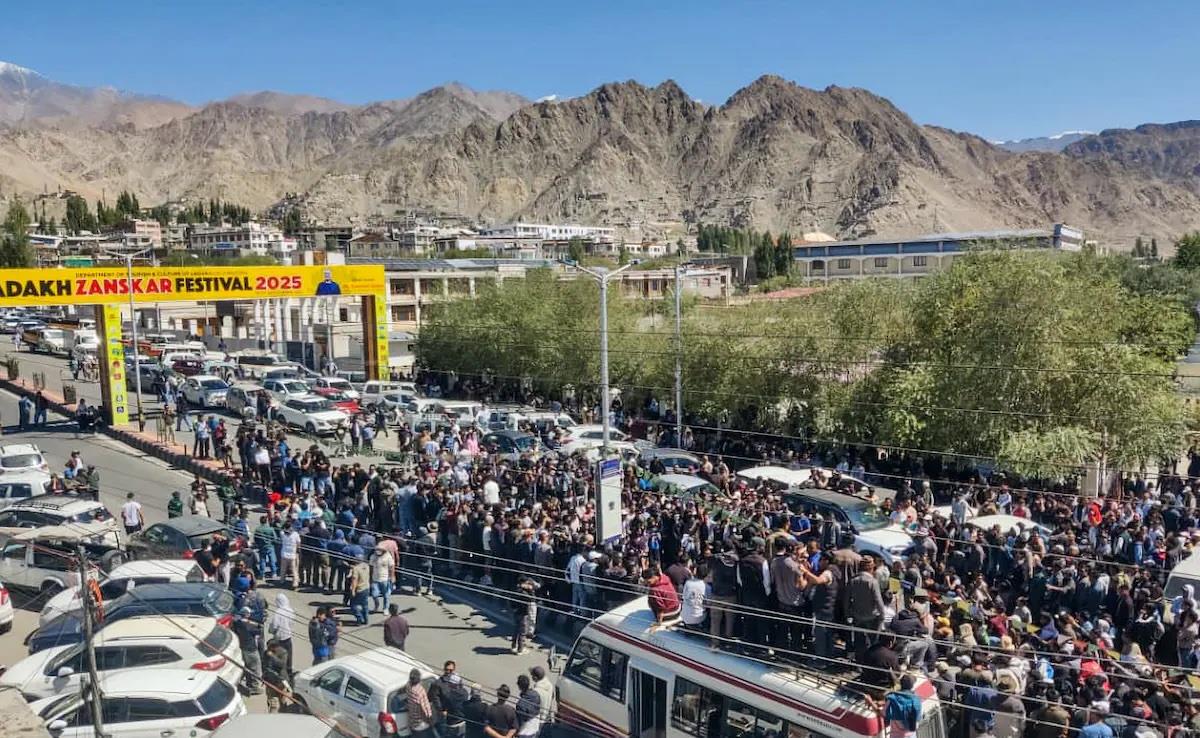Asia's Youthquake: India's Gen Z Protests Are Boiling Over
On September 24, 2025 , the narrow streets of Ladakh erupted with the chants of a restless generation. Their demands are statehood; constitutional protection under the Sixth Schedule, which provides for the creation of autonomous District Councils in certain tribal areas of the northeastern states; assured jobs; and a share of political autonomy.
Such demands might carry an almost old-world resonance, yet their urgency made them impossible to dismiss. What began as a peaceful fast, initiated under the moral weight of climate activist Sonam Wangchuk , soon descended into chaos.
Confrontations with the police spiraled out of control and, by the time dusk settled over the mountains, the toll was grim: four dead, their ages ranging from 19 to 46, and more than 80 others injured, some bearing wounds that will never fully heal.
Flames consumed the BJP's regional headquarters, a visceral expression of the chasm between New Delhi's power and its disenchanted frontier.
And if India's ruling class, and indeed the West, have any foresight left, they will recognize Ladakh's tragedy not as an aberration, but as part of a wider, continental tremor.
The common thread of Asian youth protestsLook beyond India's northern frontier and we will see the unmistakable echo of the same unrest. In Nepal earlier this month, massive Gen Z–led demonstrations forced the resignation of the prime minister. The same type of protests earlier ousted a government in Bangladesh .
Latest stories
Japan's LDP leadership race, so far, is a sluggish campaign

Trump in Truth Social manifesto offloads Ukraine mess on Europe

Europe must step up to face Russian aggression alone
The same script has played out in other Asian nations. In Sri Lank in 2022, it was young protesters who stormed the presidential palace and toppled Gotabaya Rajapaksa. In Thailand , Gen Z activists defied decades of royalist taboo to call for monarchical reform. In Hong Kong in 2019, a student-led movement stood against Beijing's tightening grip – only to be crushed by brute force and international indifference. And in Myanmar , since the coup of 2021, it is overwhelmingly young people who have borne the brunt of the resistance against military rule.
India's specific fault lineLadakh is not just any territory. Since it was carved out of Jammu and Kashmir in 2019 , it has stood at the crossroads of India's geopolitical rivalries with China and Pakistan. For New Delhi, Ladakh is a military outpost. For its young residents, however, it is home – one where they feel increasingly like strangers in their own land.
The demand for Sixth Schedule protections is telling. It reflects a fear that Ladakh's fragile culture, land, and demography will be steamrolled by outsiders once economic liberalization reaches its valleys. The demand for statehood reflects an equally basic truth: No community wants to be ruled forever as a mere“Union Territory ,” with limited self-rule and maximum bureaucratic intrusion.
The BJP, unsurprisingly, has accused the opposition Congress of orchestrating the protests. This is politics as usual in India: blame the other party, deflect responsibility and hope the public forgets. But the vehemence of the protests suggests otherwise. It takes more than opposition agitation to drive hundreds of young people to risk their lives against batons, bullets and teargas.
The West's convenient blind spotWhat is striking is the silence – or at best, the muted commentary – of the West. When young people march in Hong Kong, Western governments issue thunderous statements. When they march in Tehran , they are hailed as heroes of freedom. But when Asian youth challenge governments that the West considers strategically useful, the silence is deafening.
Ladakhis are not likely to become darlings of Western think tanks anytime soon. Their cause is inconvenient. Washington is courting India as a bulwark against China. Brussels is wooing New Delhi as a partner in trade diversification. London is looking to secure a free-trade agreement with the Modi government. And so, the young who bleed in Leh are unlikely to merit even a perfunctory line in a White House briefing.
This double standard is not lost on Asia's youth. It reinforces their suspicion that Western talk of“democratic values” is selective and self-serving. The hypocrisy weakens not just Western credibility but also the very democratic movements that the West claims to champion.
Lessons from historyHistory shows that ignoring the political energies of the young is not just cynical – it is dangerous. In 1968 , student protests from Paris to Prague reshaped the political imagination of Europe. In South Korea, it was youth-led protests in the 1980s that toppled military rule and birthed a democracy. Even in India, it was the student protests of the 1970s that catalyzed the movement against Indira Gandhi's Emergency.
Suppressing young voices with batons and bullets can buy governments temporary calm. But it almost never buys legitimacy. Instead, it radicalizes the very people whose energy could have been harnessed for constructive change.
A regional reckoningIf India's leadership believes Ladakh's unrest will remain confined to a cold desert plateau, it is deluding itself. The grievances of Gen Z are national: unemployment that hovers stubbornly high, a political culture that feels exclusionary and an economy that seems to grow without lifting their boats. The discontent in Ladakh could just as easily erupt in Uttar Pradesh, Assam or the Northeast.

Sign up for one of our free newsletters
-
The Daily Report
Start your day right with Asia Times' top stories
AT Weekly Report
A weekly roundup of Asia Times' most-read stories
Asia's other leaders would do well to pay attention. The fall of Nepal's prime minister this month should be a cautionary tale. So should the near-collapse of Sri Lanka's state in 2022. The message is consistent: ignore your youth at your peril.
Toward an honest responseWhat should be done? First, governments need to recognize that the discontent is genuine. Blaming“outside agitators” may soothe party loyalists but fools no one else. Second, there must be a willingness to cede space: more local autonomy in Ladakh, real anti-corruption reforms in Nepal and economic relief in Sri Lanka. Third, the West must resist the temptation to view Asian youth protests solely through the prism of its geopolitical chessboard. Supporting democracy selectively only fuels cynicism.
The reckoning aheadWhat happened in Ladakh is tragic, but it is not accidental. It is the symptom of a deeper continental malaise: a generation betrayed by political elites who mistake youthful patience for acquiescence.
India's leaders, like their counterparts across Asia, can still choose differently. They can embrace dialogue over suppression, reform over inertia and inclusion over exclusion. But if they do not, Gen Z will not wait. The fires that consumed the BJP's Ladakh office may, in time, consume something larger: the credibility of entire governments.
And when that day comes, the West will have to answer an uncomfortable question: why it chose silence when Asia's youngest voices demanded to be heard.
M A Hossain is a senior journalist and international affairs analyst. He may be reached at: ... .
Sign up here to comment on Asia Times stories Or Sign in to an existing accoun
Thank you for registering!
An account was already registered with this email. Please check your inbox for an authentication link.
-
Click to share on X (Opens in new window)
X
Click to share on LinkedIn (Opens in new window)
LinkedIn
Click to share on Facebook (Opens in new window)
Facebook
Click to share on WhatsApp (Opens in new window)
WhatsApp
Click to share on Reddit (Opens in new window)
Reddit
Click to email a link to a friend (Opens in new window)
Email
Click to print (Opens in new window)
Print

Legal Disclaimer:
MENAFN provides the
information “as is” without warranty of any kind. We do not accept
any responsibility or liability for the accuracy, content, images,
videos, licenses, completeness, legality, or reliability of the information
contained in this article. If you have any complaints or copyright
issues related to this article, kindly contact the provider above.
Most popular stories
Market Research

- Zebu Live 2025 Welcomes Coinbase, Solana, And Other Leaders Together For UK's Biggest Web3 Summit
- Yield Basis Nears Mainnet Launch As Curve DAO Votes On Crvusd Proposal
- Blueberry Launches A Bold New Brand Platform
- Stonehaven Circle Marks 13Th Anniversary With Hadrian Colwyn Leading Calvio Ailegacyx Innovation
- R0AR Launches Buyback Vault: Bringing 1R0R To R0AR Chain Unlocks New Incentives
- Moonbirds And Azuki IP Coming To Verse8 As AI-Native Game Platform Integrates With Story





















Comments
No comment